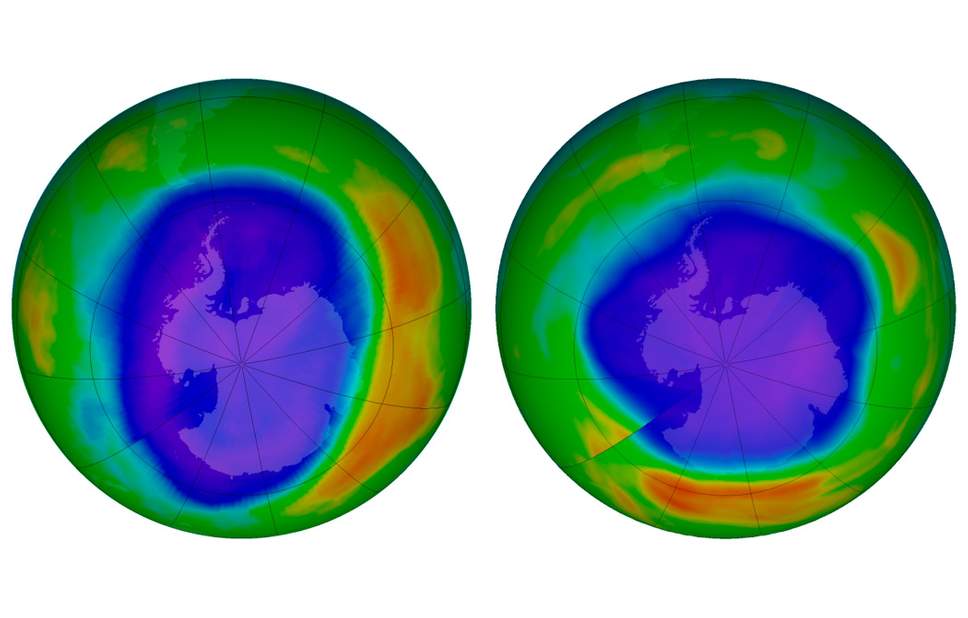Earth’s Ozone layer healing says UN
November 7, 2018 | Expert Insights

Earth’s protective ozone layer is finally healing from damage caused by aerosol sprays and coolants, a new United Nations report said.
The ozone layer had been thinning since the late 1970s. Scientists raised the alarm and ozone-depleting chemicals were phased out worldwide.
Background
The Ozone layer or ozone shield is a region of Earth's stratosphere that absorbs most of the Sun's ultraviolet radiation. It contains high concentrations of ozone (O3) in relation to other parts of the atmosphere, although still small in relation to other gases in the stratosphere. The ozone layer contains less than 10 parts per million of ozone, while the average ozone concentration in Earth's atmosphere as a whole is about 0.3 parts per million. The ozone layer is mainly found in the lower portion of the stratosphere, from approximately 20 to 30 kilometres (12 to 19 mi) above Earth, although its thickness varies seasonally and geographically.
The ozone layer absorbs 97 to 99 percent of the Sun's medium-frequency ultraviolet light (from about 200 nm to 315 nm wavelength), which otherwise would potentially damage exposed life forms near the surface.
In 1976 atmospheric research revealed that the ozone layer was being depleted by chemicals released by industry, mainly chlorofluorocarbons (CFCs). Concerns that increased UV radiation due to ozone depletion threatened life on Earth, including increased skin cancer in humans and other ecological problems, led to bans on the chemicals, and the latest evidence is that ozone depletion has slowed or stopped.
Analysis
Earth’s protective ozone layer is finally healing from damage caused by aerosol sprays and coolants, a new United Nations report said.
The ozone layer had been thinning since the late 1970s. Scientists raised the alarm and ozone-depleting chemicals were phased out worldwide.
As a result, the upper ozone layer above the Northern Hemisphere should be completely repaired in the 2030s and the gaping Antarctic ozone hole should disappear in the 2060s, according to a scientific assessment released at a conference in Quito, Ecuador. The Southern Hemisphere lags a bit and its ozone layer should be healed by mid-century.
High in the atmosphere, ozone shields Earth from ultraviolet rays that cause skin cancer, crop damage and other problems. Use of man-made chemicals called chlorofluorocarbons (CFCs), which release chlorine and bromine, began eating away at the ozone. In 1987, countries around the world agreed in the Montreal Protocol to phase out CFCs and businesses came up with replacements for spray cans and other uses.
At its worst in the late 1990s, about 10 percent of the upper ozone layer was depleted. However, since 2000, it has increased by about 1 to 3 percent per decade, the report said.
This year, the ozone hole over the South Pole peaked at nearly 9.6 million sq. miles (24.8 million sq. km). That’s about 16 percent smaller than the biggest hole recorded — 11.4 million sq. miles (29.6 million sq. km) in 2006.
The hole reaches its peak in September and October and disappears by late December until the next Southern Hemisphere spring.
The ozone layer starts at about 6 miles (10 km) above Earth and stretches for nearly 25 miles (40 km); ozone is a colourless combination of three oxygen atoms.
If nothing had been done to stop the thinning, the world would have destroyed two-thirds of its ozone layer by 2065. On its own, the ozone hole has slightly shielded Antarctica from the much larger effects of global warming — it has heated up but not as much as it likely would without ozone depletion.
Scientists don’t know how much a healed ozone hole will further warm Antarctica, but they do know the immediate effects of ozone depletion on the world and human health.
The replacements now being used to cool cars and refrigerators need to be replaced themselves with chemicals that don’t worsen global warming. An amendment to the Montreal Protocol that goes into effect next year would cut use of some of those gases.
Assessment
Our assessment is that the report is supporting evidence for the success of large-scale conversation efforts like the ban on CFCs and HFCs. We believe that continued global efforts will prove to be effective only if all countries devote their resources to the end goal of reducing environmental-damaging products.








Comments